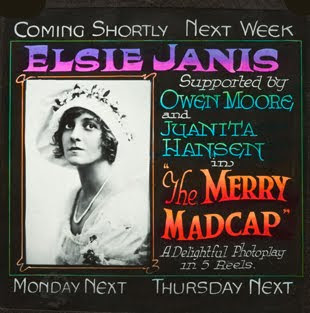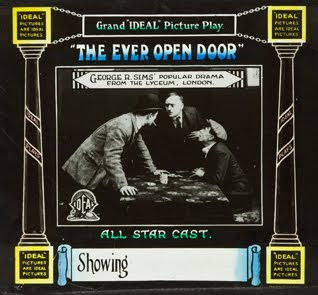Britian Goes Silent
September 11, 2010
And now! Yet another update to my global timeline. Today's update is prompted by two silent-era British slides which were brought to my attention by Donata Pesenti, conservatore at the Museo Nazionale del Cinema in Turin, Italy. I have always assumed that lantern slides had been used in Britain during the silent era, but until now had not come across specific examples.

These two examples, which are the only coming attraction slides in the Museo's vast collection of over 8,000 slides, are interesting for several reasons.
The slide for The Merry Madcap (USA, 1915) is notable because it is the earliest non-US coming attraction slide that I have encountered. It measures to the standard European dimension of 3 ¼ square and was professionally manufactured. It is also interesting that even at this very early stage, this UK slide included the four pre-printed choices for advertising the program start date: "Coming Shortly," "Next Week," "Monday Next," and "Thursday Next."
These are exactly the same options, and printed in exactly the same format, that UK slides use all the way into the 1950s (described in my August 4 article, Attractions Across the Atlantic.)

The other second slide in the Museo collection advertises The Ever Open Door (UK, 1920), and represents the earliest non-US slide I have encountered for a film not produced in the United States. The film was a crime drama produced by Ideal Studios ("'IDEAL' Pictures are Ideal Pictures") in the UK, directed by Fred Goodwins and starring Hayford Hobbs, Daphne Glenn, Margaret Hope, Sydney Wood, Terence Cavanagh, and Ralph Forster.
With these new examples, my work-in-progress (and sure to be revised again shortly) timeline of professionally produced coming attraction slides looks like this
- Australia: 1930-1982
- Canada: 1943-44
- India: Professional slides, time line coming soon
- Ireland: Only hand-made slides
- Netherlands: Only hand-made slides
- New Zealand: Evidence of professional slides, no specific examples yet
- UK: 1915-1956
- USA: 1913-1952
One final observation regarding the Museo collection comes not by way of what is in the collection, but what is not. What cannot be found in their collection are coming attraction slides from any other European country. The Museo is a very important and prestigious institution with an incredibly rich collection, and yet not a single coming attraction from any other country. While my search goes on, I am beginning to think that European cinemas did not regularly use lantern slides to advertise motion pictures. In fact, with the exception of India, perhaps the practice is unique to countries where English the the primary language.
Will this theory hold up?
Stay tuned...
